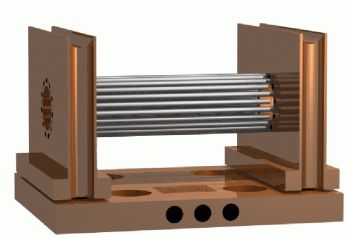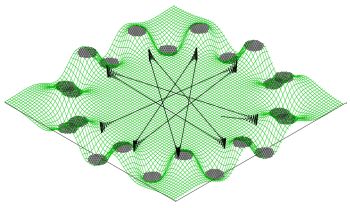Holger Kreckel
|
|
22-Pole ion trapMolecular ions play an important role in many fields and environments, from combustion to the Earth's atmosphere, astronomical plasmas and cold interstellar clouds. Experiments with molecular ions are notoriously difficult since (1) typical densities are much lower than for neutral species, (2) the ionization process usually results in widespred internal excitation (vibrations and rotations). To deal with these issues, it is advantageous to accumulate molecular ions in ion traps and cool them actively in collisions with buffer gas. During my PhD at the Max-Planck-Institute for Nuclear Physics, I have constructed a cryogenic 22-Pole ion trap in collaboration with D. Gerlich at Chemnitz University. This radiofrequency (rf) trap can be utilized as a cold ion injector for the TSR storage ring, and it can also be used for stand-alone experiments. Multipole ion traps have the significant advantage -- when compared to a traditional Paul or Quadrupole trap -- that the trap geometry creates a large field-free region in the trap center. As a consequence the ions are exposed to the rf field only at large radii and rf heating is strongly suppressed. This allows for much lower temperatures. |
|

22-pole ion trap. |

Trajectory of a trapped ion |
|
The figure above (left panel) shows an isometric view of the ion trap. The trap is about 4 cm long. It consists of 22 rods with 1 mm diameter that are planted alternatingly into two copper side plates. By applying suitable rf fields to the side plates, a ponderomotive radial trapping potential is created that can capture positive and negative ions alike. For the confinement along the trap axis two end electrodes are situated inside the side plates (not shown). The entire trap is mounted on the second stage of a 10 K cryo-head. The right panel shows the simulated trajectory of a particle in a 2-dimensional 22-pole potential. As can be seen the ion travels unperturbed through the trap center and begins to see the rf field at larger radii. This results in a small wiggling motion. The conditions in this example were chosen such that the wiggling motion is emphasized. Under normal operating conditions it is strongly suppressed. The ion trap has been used to perform Dissociative Recombination measurements at the TSR storage ring. It was also used to carry out spectroscopy measurements of weak H3+ overtone transitions with less than 1000 stored H3+ ions. These measurements are probably the most sensitive spectroscopy experiments ever made with molecular ions. |
|
|
|
| Updated: Nov 11 2010 H. Kreckel |